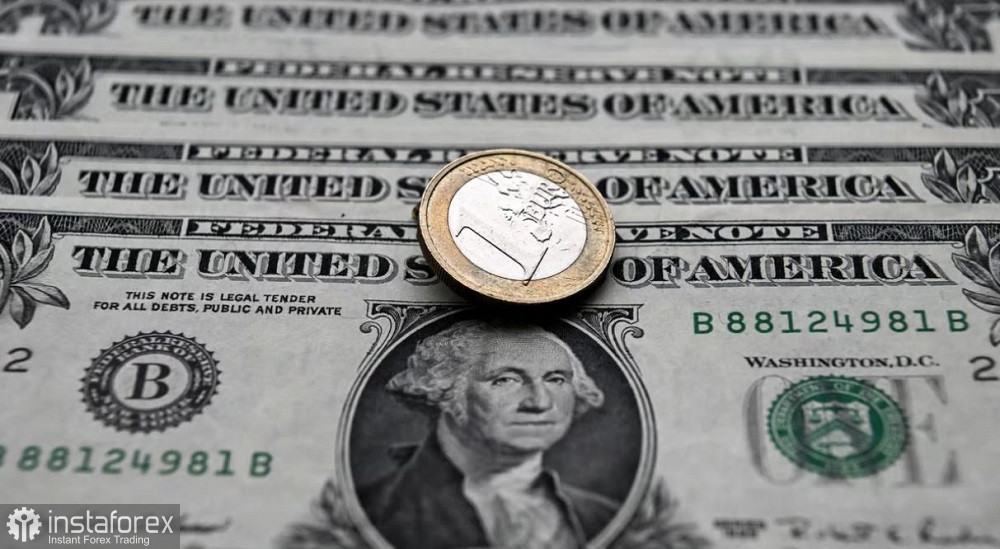The EUR/USD currency pair is trading in a narrow price range but remains within the 9-figure range. The contradictory fundamental background prevents traders from determining the price movement vector. EUR/USD buyers are attempting to establish themselves above the 1.0960 level (upper Bollinger Bands line on the four-hour chart), while sellers are making mirror attempts to pull the price towards the base of the 9-figure or even below the 1.0880 level (lower Bollinger Bands line on H4). Both sides have not emerged victorious, and the pair is fluctuating in the range of 1.0910 – 1.0960, reflecting the indecision of both bulls and bears.

Traders essentially ignored yesterday's speech by ECB President Christine Lagarde. In essence, she did not say anything new, so the impact of this fundamental factor was extremely limited. Speaking in the European Parliament, she reiterated that it is too early to declare victory over inflation despite the downward dynamics of key indicators. According to the ECB's forecasts, the weakening of inflationary pressure will continue, but in the coming months, the overall Consumer Price Index may rise again.
Lagarde said the regulator will closely monitor various factors influencing inflation and "firmly adhere to the mandate of ensuring price stability." In other words, the ECB head voiced general statements without any specifics but demonstrated a combat readiness, warning of an acceleration of inflation in the coming months. Traders clearly expected more from Lagarde, so after her speech, the pair suspended its intraday growth and drifted within the range of 1.0930–1.0950.
At the same time, risk-off sentiments intensified in the market yesterday, putting the pair under background pressure. China was again in the spotlight. Stock indices of the largest countries in the Asia-Pacific region declined on Monday—in particular, China's Shanghai Composite index fell by 0.3%, Hong Kong's Hang Seng by 0.2%, and Japan's Nikkei 225 by 0.5%. Such dynamics were due to negative news flow. In particular, it became known that in January–October, the profits of large Chinese companies decreased by almost 8% (7.8%) year-on-year.
In addition, market participants reacted to the news that Zhongzhi Enterprise, the largest Chinese asset management company, informed investors that it could not meet its obligations. In a letter to investors, the investment fund stated that it could no longer service its debts. According to some experts, this will lead to a wave of bankruptcies of banks, trust and insurance companies due to ZE's close ties to the development business (according to other analysts, the company does not pose a systemic threat to the real estate and financial sectors).
However, during the European session on Tuesday, the overall market sentiment improved, as evidenced by the rise in S&P 500 futures. Market participants, apparently, paid attention to the sustainable recovery of the U.S. bond market, as the yield on 10-year Treasury again dropped below the key level of 4.40% (4.3940% at the moment).
As mentioned earlier, buyers of the pair need to achieve the "minimum program," that is, establish themselves above the target of 1.0960 (upper Bollinger Bands line on the H4 timeframe). The next destination is the level of 1.1030 (upper Bollinger Bands line on the D1 timeframe). Traders have been testing the 1.0960 level for the second consecutive week, but each time, they bounce off it, declining towards the base of the 9-figure.
The caution of EUR/USD buyers is justified, as key inflation growth data for the eurozone will be published in just two days. It's essential to remember that the pair is holding its ground not only due to the overall weakness of the U.S. dollar but also thanks to the decent positions of the euro, which is finding support from the ECB.
European Central Bank representatives have indeed recently tightened their rhetoric, hinting at possible additional interest rate hikes. However, if inflation in the eurozone slows more than expected, the "hawkish wing" of the European regulator may come under pressure and likely soften its stance. Consequently, the euro will lose an important fundamental advantage. Note that a decrease in both the overall and core CPI is expected in November. Therefore, EUR/USD buyers will be assisted only by a green inflation report.
However, support for the pair's bulls may also come from the U.S. release. As is known, on Thursday, the core PCE index will be announced—one of the Fed's "favorite" inflation indicators. Here, too, a downward trend is expected (down to 3.5%). A more significant decline in the indicator will exert additional pressure on the greenback, allowing EUR/USD buyers to make a leap towards the 10-figure range.
Thus, traders of the pair are awaiting key macroeconomic releases of the week. In the face of such uncertainty, one should not expect any decisive actions from buyers/sellers of the pair. Probably, in the near future (until Thursday), the pair will continue to drift in the range of 1.0910–1.0960.
 English
English 
 Русский
Русский Bahasa Indonesia
Bahasa Indonesia Bahasa Malay
Bahasa Malay ไทย
ไทย Español
Español Deutsch
Deutsch Български
Български Français
Français Tiếng Việt
Tiếng Việt 中文
中文 বাংলা
বাংলা हिन्दी
हिन्दी Čeština
Čeština Українська
Українська Română
Română

